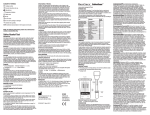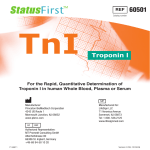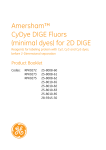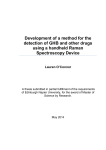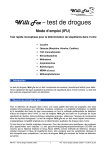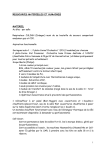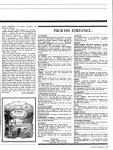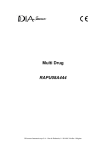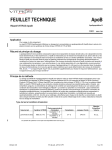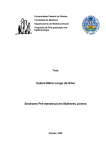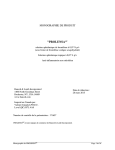Download StatusFirst DOA Package Insert
Transcript
P-58150 nervous system and can produce euphoria, respiratory depression and coma when it is abused. Morphine is the prototype compound of opiates. Morphine is excreted in the urine as morphine-3-glucuronide, unchanged morphine, and other minor metabolites. Heroin is metabolized to morphine and codeine and excreted in the urine with a small amount of unchanged form. Codeine is also excreted as morphine and in the form of conjugates. Although some opiate metabolites appear in the feces, urinary excretion is the primary route of elimination.1,2,3 StatusFirst™ DOA 10 (MET/OPI/COC/THC/PCP/ BZO/BAR/MTD/TCA/AMP) Cocaine (COC), derived from the leaves of coca plant, is a potent central nervous system (CNS) stimulant and a local anesthetic. Cocaine induces euphoria, confidence and a sense of increased energy in the user; these psychological effects are accompanied by increased heart rate, dilation of the pupils, fever, tremors and sweating. Cocaine is used by smoking, intravenous, intranasal or oral administration, and excreted in the urine primarily as benzoylecgonine in a short time. Benzoylecgonine has a longer biological half-life (5–8 hours) than cocaine (0.5–1.5 hours) and can generally be detected for 24–60 hours after cocaine use or exposure.3,5 StatusFirst™ DOA 5 (MET/OPI/COC/THC/PCP) New One-Step Panel Test for Drugs of Abuse with DXpress® Reader THC (Δ9-tetrahydrocannabinol) is the primary active ingredient in cannabinoids (marijuana). When ingested or smoked, it produces euphoric effects. Users experience impairment of short term memory and THC use slows learning. Also, it may cause transient episodes of confusion, anxiety, or frank toxic delirium. Long term, relatively heavy use may be associated with behavioral disorders. The peak effect of smoking THC occurs in 20–30 minutes and the duration is 90– 120 minutes after one cigarette. Elevated levels of urinary metabolites are found within hours of exposure and remain detectable for 3–10 days after smoking. The main metabolite excreted in the urine is 11-nor-Δ9-tetrahydrocannabinol-9carboxylic acid.1 For in vitro Use Only Simple One-Step Immunoassay for the Qualitative Detection of Methamphetamine, Opiates, Cocaine, THC Phencyclidine, Benzodiazepines, Barbiturates, Methadone, Tricyclic Antidepressants, Amphetamine, and/or their Metabolites in Urine Phencyclidine (PCP) is an arylcyclohexylamine that is used as a veterinary anesthetic. It is used illegally as a hallucinogen, and is commonly referred to as PCP, angel dust, love boat, hog, or killer weed. PCP can produce lethargy, euphoria, ataxia, nystagmus and coma. Currently a number of PCP analogues with similar pharmacological effects are in use as street drugs, including PCE, PHP, TCP, and ketamine. Phencyclidine is readily absorbed when smoked or ingested, or even through skin contact. It is metabolized in the liver. Evidence indicates that PCP undergoes oxidative metabolism to at least 2 inactive metabolites, 4phenyl-4-piperidino-cyclohexanol and 1-(1-phenylcyclohexyl)-4hydroxypiperidine, which are excreted as glucuronide conjugates in the urine. About 10% of the dose is excreted in urine as the parent compound, phencyclidine.2,3 LifeSign, LLC Stock No. DOA 10 30025 30010 25 Test Kit 10 Test Kit DOA 5 30525 25 Test Kit Intended Use Benzodiazepines (BZO) are a class of widely prescribed central nervous system (CNS) depressants and include widely used drugs such as chlordiazepoxide, diazepam, and oxazepam. They have medically useful properties, including antianxiety, sedative, anticonvulsant, and hypnotic effects. They are taken orally or sometimes by injection, and have a low potential for physical or psychological dependence. Benzodiazepines induce drowsiness and muscle relaxation; however, their use can also result in intoxication, similar to drunken behavior except without evidence of alcohol use, and the loss of inhibitions. Chronic abuse can result in addiction and tardive dyskinesia (involuntary muscle movements of the face, limbs, and trunk). Overdose can result in coma and possible death. Withdrawal syndrome includes anxiety, insomnia, tremors, delirium, and convulsions. The effects of benzodiazepine use last 4–8 hours. The different benzodiazepines are absorbed at different rates, and the timing of their psychoactive effects varies with the absorption rate. The drugs are excreted in the urine primarily as the parent compounds or as oxazepam glucuronide, an inactive metabolite, (in the case of chlordiazepoxide and diazepam) and are detectable for 1–2 days. Oxazepam may be detectable in the urine for up to 7 days. 2,3 StatusFirst DOA 10 test is a simple, one-step immunochromatographic assay for the rapid, qualitative detection of methamphetamine, opiates, cocaine metabolites, THC metabolites, phencyclidine, benzodiazepines, barbiturates, methadone, tricyclic antidepressants, amphetamine, and/or their metabolites present in human urine above the cutoff concentration of the drug specified. StatusFirst™ DOA 5 test detects methamphetamine, opiates, cocaine metabolites, THC metabolites, phencyclidine, and/or their metabolites. ™ The StatusFirst™ DOA 10/DOA 5 test provides only a preliminary analytical result. A more specific alternative chemical method must be used in order to obtain a confirmed analytical result. GC/MS or HPLC (for TCA) is the preferred confirmatory method. Other chemical confirmatory methods are available. Clinical consideration and professional judgment should be applied to any drug of abuse test result, particularly when preliminary positive results are obtained.2 Summary and Explanation Methamphetamine (MET) is a potent sympathomimetic agent with therapeutic applications. The drug can be taken orally, injected, or inhaled. Acute higher doses lead to enhanced stimulation of the central nervous system and induce euphoria, alertness, reduced appetite, and a sense of increased energy and power. Cardiovascular responses to methamphetamine include increased blood pressure and cardiac arrhythmias. More acute responses include anxiety, paranoia, hallucinations, psychotic behavior, and eventually, depression and exhaustion. The effects of methamphetamine generally last 2–4 hours, and the drug has a half-life of 9–24 hours in the body. Methamphetamine is excreted in the urine primarily as amphetamine and oxidized and deaminated derivatives.3 However, 10–20% of methamphetamine is excreted unchanged. Thus, the presence of the parent compound in the urine indicates methamphetamine use. Methamphetamine is generally detectable in the urine for 3–5 days, depending on urine pH level. Morphine, codeine, and semisynthetic derivatives of morphine belong to the class of drugs called opiates (OPI). An opiate exerts its effects on the central 1 Barbiturates (BAR) are a group of chemicals derived from barbituric acid. Classified as hypnotics, they depress the central nervous system. Taken orally in pill or tablet form, they are prescribed for many medical conditions, usually for their sedative effect. Abuse of barbiturates can, however, lead not only to impaired motor coordination and mental disorder, but also to respiratory collapse, coma and death. The combination of barbiturates and alcohol is particularly dangerous. Symptoms of barbiturate abuse include drowsiness, slurred speech and irritability. Acute conditions include respiratory collapse and loss of consciousness. Chronic conditions include addiction, abstinence, seizures, and death. The effects of short-acting barbiturates such as pentobarbital and secobarbital last 3 to 6 hours. The effects of long-acting barbiturates last 10 to 20 hours. Phenobarbital is an example of long-acting ones. Barbiturates normally remain detectable in urine for 4 to 6 days in the case of short-acting ones and up to 30 days for long-acting ones. Short-acting barbiturates is generally excreted as metabolites, while long-acting ones primarily appear unchanged.2,3 Materials Provided Methadone (MTD) is a synthetic analogic drug which possesses many of the pharmacologic properties of morphine. Unlike morphine, however, methadone produces marked sedative effects with repeated administration as a result of drug accumulation. Over dosage with methadone is characterized by stupor, muscle flaccidity, respiratory depression, cold and clammy skin, pupillary constriction, hypotension, coma and circulatory collapse. Fatalities in adults from methadone over dosage have increased significantly in many urban areas as a result of widespread availability of the drug, both from licit and illicit sources.2,3 The StatusFirst DOA 10/DOA 5 test kit contains all the reagents necessary to perform the assay. ™ • Tricyclic antidepressants (TCAs) are a type of prescription drug intended for clinically depressed patients. Unfortunately, they are becoming more frequently abused and are now one of the leading causes of death by drug overdose in the United States. There are two broad chemical classes of TCAs. The tertiary amines—amitriptyline, imipramine, trimipramine and doxepin—boost serotonin levels and are prescribed for insomnia, irritability and over stimulation. The secondary amines—nortriptyline, desipramine and protryptiline—enhance norepinephrine levels and are prescribed for opposite types of symptoms, such as excessive fatigue, withdrawal and inertness.1 Abuse of TCAs may lead to coma, respiratory depression, convulsions, blood pressure deviations, hyperprexia and severe cardiac conditions. TCAs are excreted in urine mostly in the form of metabolites for up to ten days.3,7,8 • • StatusFirst™ DOA 10/DOA 5 device. The test device contains membrane strips and dye pads: Membrane strips are coated with THC-protein (from a purified bovine protein source) conjugate, PCP-protein (from a purified bovine protein source) conjugate, monoclonal anti-methamphetamine, anti-morphine, anti-benzoylecgonine, anti-barbiturate and anti-amphetamine antibodies, as well as polyclonal sheep anti-oxazepam, antimethadone and anti-tricyclic antidepressant antibodies. Sheep antimouse antibody is coated for the control bands. Dye pads contain colloidal gold coated with monoclonal anti-THC, anti-phencyclidine, and mouse IgG antibodies as well as conjugates of methamphetamine, morphine, benzoylecgonine, oxazepam, barbiturate, methadone, nortriptyline analogue and amphetamine (each drug is conjugated with purified bovine source protein). Disposable sample dispenser. Instructions for use. Precaution Amphetamine (AMP) is a potent sympathomimetic agent with therapeutic applications. The drug can be taken orally, injected, or inhaled. Acute higher doses lead to enhanced stimulation of the central nervous system and induce euphoria, alertness, reduced appetite, and a sense of increased energy and power.5 Cardiovascular responses to amphetamine include increased blood pressure and cardiac arrhythmias. More acute responses include anxiety, paranoia, hallucinations, psychotic behavior, and eventually, depression and exhaustion. The effects of amphetamine generally last 2–4 hours, and the drug has a half-life of 9–24 hours in the body. Amphetamine is excreted in the urine in unchanged form and also as hydroxylated and deaminated derivatives.3,6 • • • • • • Principle For in vitro diagnostic use only. Avoid cross contamination of urine samples by using a new urine specimen container and dropper for each urine sample. The test kit does not contain any HIV or hepatitis infective components. Urine specimens are potentially infectious. Proper handling and disposal methods should be established according to good laboratory practices. The StatusFirst™ device should remain in its original sealed pouch until ready for use. Do not use the test if the pouch is damaged or the seal is broken. Do not use the test kit after the expiration date. Storage and Stability The StatusFirst™ DOA 10/DOA 5 test uses solid-phase chromatographic membrane immunoassay technology for the qualitative, simultaneous detection of methamphetamine, opiates, cocaine, THC, phencyclidine, benzodiazepines, barbiturates, methadone, tricyclic antidepressants, and amphetamine in human urine. The test is based on the principle of the highly specific immunochemical reactions between antigens and antibodies which are used for the analysis of specific substances in biological fluids. The test relies on the competition to bind to the antibodies between the drug conjugates and the drugs which may be present in the urine sample. In the test procedure, a sample of urine is placed in the Sample well of the device and is allowed to migrate upward. If the drug is present in the urine sample, it competes with the drug conjugate, which is bound to the dye, for the limited antibodies immobilized on the membrane. If the drug or drug metabolite levels are above the cutoff level, the drug will saturate the antibodies, thus inhibiting the binding of the dye coated with drug conjugates to the antibodies on the membrane. This prevents the formation of a line on the membrane. Therefore, a drug-positive urine sample will not generate a line in the test window, indicating a positive result from positive drug competition, while a negative urine sample will generate a line in the test window, indicating a negative result from an absence of competition with free drugs. The StatusFirst DOA 10/DOA 5 test kit should be stored at 2–30°C (35–86°F) in the original sealed pouch. The expiration dating was established under these storage conditions. ™ Specimen Collection and Preparation Fresh urine specimens do not require any special handling or pretreatment. Specimens should be collected in a clean glass or plastic container. If testing will not be performed immediately, specimens should be refrigerated (2–8°C) or frozen. Frozen specimens must be completely thawed, and thoroughly mixed before using. Specimens containing a large amount of particulate matter may give inconsistent test results. Such specimens should be clarified by centrifuging or allowing settling before testing. Test Procedure The test procedure consists of adding the urine sample to the Sample well of the device and reading the test result at 5 min after sample addition using a DXpress™ Reader. In addition to the Test line that may appear in the Test window (T), a Control line is present in the Control window (C) to confirm the viability of the test. This Control line (validation line) should always appear if the test is conducted properly. Polyclonal sheep anti-mouse antibody is immobilized on the control line. The monoclonal antibody-dye conjugates that pass the region will be captured and produce a colored line in the Control window (validation line). This works as a procedural control, confirming that proper sample volume was used and the reagent system at the control line and the conjugate-color indicator worked. If insufficient sample volume is used, there may not be a Control line, indicating the test is invalid. DXpress™ Reader Procedure Consult the DXpress™Reader User Manual. For DXpress™ Reader installation, start up and complete instructions refer to the DXpress™ Reader User Manual. Operator must consult the DXpress™ Reader User Manual prior to use and become familiar with the processes and quality control procedures. 2 See Reader procedure StatusFirst™ DOA 10: Add 2 drops in each sample well ID 2 drops Sample 2 drops Reader reading at 5 minutes StatusFirst™ DOA 5: Add 3 drops in the sample well ID 32 drops Sample Performing Self Check 3. Each time the DXpress™ Reader is turned on, Self Check is automatically performed and the operator may then proceed to “Performing Calibration QC”. If the DXpress™ Reader is left on or in power save mode, the operator should perform Self Check daily as follows: 1. 2. 3. 4. Testing Patient Samples From the Main Menu, select [2] RUN QC Select [1] SELF CHECK Self Check takes about 15 seconds. PASS or FAIL results will be displayed/printed when testing is completed. All Self Check items should pass before testing patient samples. Press ENTER from the Self Check result screen to return to the RUN QC menu; proceed to Step 2 of “Performing Calibration QC”. Patient samples may be tested using the DXpress™ Reader Scheduler mode, as described below. To use other modes (batch mode or read-now mode) please consult the DXpress™ Reader User Manual. 1. 2. 3. 4. • • • Performing Calibration QC Each day of patient testing, use the QC Calibration Set (see DXpress™ Reader manual) to ensure the DXpress™ Reader functions properly: 1. 2. 3. 4. 5. 6. 7. 8. 8. 9. • • • • From the Main Menu, select [2] RUN QC Select [2] CALIBRATION QC Either input Operator ID manually and press ENTER or scan Operator ID barcode. Scan the QC Calibrator ID barcode, found on the back of the QC Calibrator. Insert the QC Calibrator into the reader – be sure to close the Tray – and press ENTER. Follow prompts displayed on the screen. A CALIBRATION OK result will be displayed/printed when the calibration is completed. Press ENTER to perform “Blank Calibration”. Select CALIBRATE, and press ENTER. Select Double Window Cassette, and press ENTER. Insert a Blank Calibrator double window device, and press ENTER. Reader will display “Successfully Performed.” Press ENTER to return to the Main Menu. • • • or of sample into EACH sample well. When drawing sample into the dropper, avoid introducing air bubbles. Do not touch the sample well or test device with the tip of the dropper. Immediately press ENTER Insert the test device in the Reader tray, close the Reader tray. After 5 minutes of incubation the DXpress™ Reader will automatically read and display the results on the screen. NOTE: To view results of all drugs, press [Left] and [Right] navigation key to switch between the left and right windows. Pressing [PRINT] will print results for both windows in one step. Running QC with External Controls The manufacturer recommends the use of commercially available controls. From Main Menu, select Select Open the pouch and remove the test device. Label the patient ID on the test device with a permanent marker. Place the test device on a level surface. Testing the Patient Sample on the DXpress™ Reader: From the Main Menu, select [1] RUN PATIENT Scan lot number barcode from the pouch or kit box. Confirm test device information (lot number and type of test device) as displayed on the screen and press ENTER Scan the Operator ID barcode (or manually enter). Scan the Patient ID barcode (or manually enter). From the Incubation Time window, select SCHEDULER Add patient sample to test device by holding the dropper in a vertical position and dispense 2 drops for StatusFirst™ DOA 10 3 drops for StatusFirst™ DOA 5 Calibration should succeed before running daily patient testing. 1. 2. Follow the same procedure as if running a patient sample; please see section “Testing Patient Samples” below. The only difference is that RUN PATIENT requires a Patient ID, whereas EXTERNAL QC requires a Sample ID. [2] RUN QC [3] EXTERNAL QC 3 Expected Values Report of Results The result of positive or negative for each analyte is detrmined by the DXpress™ Reader. • • StatusFirst DOA 10/DOA 5 is a qualitative test. The amount of methamphetamine, opiates, cocaine, THC, phencyclidine, benzodiazepines, barbiturates, methadone, tricyclic antidepressants, amphetamine, and/or their metabolites present in the urine cannot be estimated by the test. The test results distinguish positive from negative samples. Positive results indicate the samples contain methamphetamine, opiates, cocaine, THC, phencyclidine, benzodiazepines, barbiturates, methadone, tricyclic antidepressants, amphetamine, and/or their metabolites above the cutoff concentration. The StatusFirst™ DOA 10/DOA 5 test has been shown to detect each drug at following cutoff: 1000 ng/mL of methamphetamine, 300 ng/mL of morphine, 300 ng/mL of benzoylecgonine, 50 ng/mL of THC, 25 ng/mL of phencyclidine, 300 ng/mL of oxazepam, 300 ng/mL of secobarbital, 300 ng/mL of methadone, 1000 ng/mL of nortriptyline and 1000 ng/mL of amphetamine in urine. ™ Results may be printed by pressing the PRINT button. At this point the test device may be removed and appropriately discarded. Result Example Control:Valid MET: Negative OPI: Positive COC: Negative THC: Negative PCP: Negative Control:Valid BZO: Negative BAR: Negative MTD: Negative TCA: Positive AMP: Negative Performance Characteristics Accuracy Invalid The accuracy of StatusFirst™ DOA 10/DOA 5 was evaluated in comparison to the result of GC/MS (HPLC for TCA). For each drug, over 60 clinical samples containing some amount of the drug were tested and the results were compared to the GC/MS or HPLC values. In addition, 100 drug-free urine samples were collected from people who apparently were not taking the drug and were tested. The instrument will automatically determine the control line is not present. If the result is invalid, the sample should be retested with a new device. If the problem persists, contact your local distributor of LifeSign. Limitations • • • • • • The summary of results is shown in Table 1. The test is designed for use with unadulterated urine only. There is a possibility that factors such as technical or procedural errors, as well as other substances in the urine sample which are not listed in Tables 11 below, may interfere with the test and cause erroneous results. Adulterants, such as bleach and/or alum, in urine specimens may produce erroneous results regardless of the method of analysis. If adulteration is suspected, the test should be repeated with a new sample. Certain foods or medications containing opiates or opiate derivatives, amphetamins, methamphetamine, barbiturate, benzodiazepines, or tricyclics may produce a positive result in any chemical or immunological assay. Poppy seeds can contain opiates and ingestion of products containing poppy seeds can cause a positive result. The test result read after 5 minutes may not be consistent with the original reading obtained at 5 minute reading period. The test must be read at 5 minutes of sample application. A negative test result does not indicate the absence of drug in the sample, it only indicates the sample does not contain drug above the cutoff level in qualitative terms. A positive test result does not provide any indication of the level of intoxication or urinary concentration of the drug in the sample, it only indicates the sample contains drug above the cutoff level in qualitative terms. Table 1. The Results Summary of Comparison Study to Reference Method (GC/MS or HPLC) with Clinical Samples † Clinical samples were grouped A through E based on each drug concentration as shown below: A: Drug-free B: Negative (between 0 and 50% cutoff) C: Negative (between 50% cutoff and cutoff) D: Cutoff (between cutoff and 150% cutoff) E: Positive (≥150% cutoff) Drug Conc. Range† Drug THC OPI COC User Quality Control Internal Control: Each StatusFirst™ test device has a built-in control. The Control line is an internal positive process control. A distinct reddish-purple Control line should always appear in the position: if the test procedure is performed properly, an adequate sample volume is used, the sample and reagent are wicking on the membrane, and the test reagents at the control line and the conjugate-color indicator are working. In addition, if the test has been performed correctly and the device is working properly, the background in the result window will become clear and provide a distinct result. This may be considered an internal negative process control. The DXpress Reader will report “Control: Valid” and test results when Internal Control QC is satisfied. MET PCP BZO BAR The positive and negative process controls contained in each StatusFirst™ test device satisfy the requirements of testing a positive control and a negative control on a daily basis. If the Control line does not appear in the Control window, the test is invalid and a new test should be performed. If the problem persists, contact LifeSign for technical assistance. MTD TCA External Control: External controls may also be used to assure that the reagents and assay procedure are performing properly. It is recommended that a control be tested at regular intervals as good laboratory testing process. For information on how to obtain controls, contact LifeSign’s Technical Services. AMP 4 Result A B Pos. 0 Neg. 100 % Agreement with Reference Test C D E 0 0 11 40 98 (51/52) 7 10 0 1 100 (117/117) Pos. 0 1 4 8 49 100 (57/57) Neg. 100 15 8 0 0 96 (123/128) Pos. 0 0 2 5 47 98 (52/53) Neg. 100 13 11 1 0 98 (124/126) Pos. 0 0 6 6 42 98 (48/49) Neg. 100 14 5 1 0 95 (119/125) Pos. 0 0 0 14 49 95 (63/66) Neg. 100 6 9 1 2 100 (115/115) Pos. 0 0 3 6 53 100 (59/59) Neg. 100 7 7 0 0 97 (114/117) Pos. 0 0 0 4 42 98 (46/47) Neg. 100 10 8 1 0 100 (118/118) Pos. 0 0 1 6 71 99 (77/78) Neg. 100 10 8 0 1 99 (118/119) Pos. 0 0 0 5 36 100 (41/41) Neg. 100 11 9 0 0 100 (120/120) Pos. 0 0 1 8 39 96 (47/49) Neg. 100 16 13 2 0 99 (129/130) Precision and Cutoff Validation Study Cocaine Test For the precision and cutoff value validation of each drug test on the panel, spiked urine controls with concentrations of 0, 50% below cutoff, 25% below cutoff, cutoff, 25% above cutoff, 50% above cutoff and 100 % above cutoff levels were tested. Ten (10) devices at each concentration were tested on three readers for two days with two lots of test devices by three operators blindly. The summary of the results are shown in table 2. Drug Conc. (ng/mL) All test results with the samples of negative or 100% above cutoff level agreed with expected results in both reader and visual reading. With +50% cut off level the results showed from 98 to 100% agreements with expected results. There were no significant differences between device lots and days. Table 2. Precision Study for StatusFirst DOA 10/DOA 5 ™ # Tested +/–* % Agreement 0 120 0/120 100 150 120 1/119 99 225 120 30/90 75 300 120 83/37 N/A 375 120 111/9 93 450 120 120/0 100 600 120 120/0 100 Tested +/–* % Agreement Drug Standards and Cutoff Values for Each Drug Test Cutoff Conc.(ng/mL) Test Name Drug Standard Methamphetamine d-methamphetamine Opiates Morphine 300 Cocaine Benzoylecgonine 300 THC 11-nor-Δ9-THC-9-COOH Phencyclidine THC Test 1000 Phencyclidine Drug Conc. (ng/mL) # 50 0 120 0/120 100 25 25 120 0/120 100 37.5 120 9/111 93 N/A Benzodiazepine Oxazepam 300 Barbiturate Secobarbital 300 Methadone Methadone 300 Tricyclic Antidepressant Nortriptyline 1000 Amphetamine d-Amphetamine 1000 50 120 72/48 62.5 120 109/11 91 75 120 117/3 98 100 120 120/0 100 +/–* % Agreement Phencyclidine Test *+/–: # of Pos./# of Neg. Methamphetamine Test Drug Conc. (ng/mL) Drug Conc. (ng/mL) # # Tested 0 120 0/120 100 Tested +/–* % Agreement 12.5 120 0/120 100 0 120 0/120 100 18.8 120 6/114 95 500 120 0/120 100 25 120 68/52 N/A 750 120 22/98 82 31.3 120 117/3 98 1000 120 73/47 N/A 37.5 120 119/1 99 1250 120 113/7 94 50 120 120/0 100 1500 120 119/1 99 2000 120 120/0 100 Tested +/–* % Agreement 0 120 0/120 100 150 120 0/120 100 225 120 24/96 80 300 120 77/43 N/A 375 120 110/10 92 450 120 120/0 100 600 120 120/0 100 Benzodiazepine Test Drug Conc. (ng/mL) Opiates Test Drug Conc. (ng/mL) # Tested +/–* % Agreement 0 120 0/120 100 150 120 0/120 100 225 120 1/119 99 300 120 58/62 N/A 375 120 99/21 83 450 120 117/3 98 600 120 120/0 100 5 # Barbiturate Test Drug Conc. (ng/mL) Reproducibility 0.5X cutoff, and 2X cutoff levels of each of 10 drugs’ samples were prepared by spiking each drug standard solution into the drug negative urine. The prepared samples including negative urine were aliquoted for each test and given blindly to each site. Thirty (30) tests for each drug (10 tests at each concentration) for a total of 300 tests per site were tested at three POL sites. Results demonstrated 99 % (895 out of 900 tests) agreement among the three sites. # Tested +/–* % Agreement 0 120 0/120 100 150 120 3/117 98 225 120 27/93 78 300 120 81/39 N/A 375 120 110/10 92 450 120 120/0 100 600 120 120/0 100 Specificity The following table lists compounds that were evaluated with the StatusFirst™ DOA 10/DOA 5 test for specificity. The specificity of the StatusFirst™ DOA 10 test was determined by adding various drugs and drug metabolites to drugnegative urine specimens and testing with the StatusFirst™ DOA 10/DOA 5 test. The results are expressed in terms of the minimum concentration required to produce a positive result (Table 3). Methadone Test Drug Conc. (ng/mL) Table 3. Specificity Compound # Tested +/–* % Agreement 0 120 0/120 100 150 120 2/118 98 225 120 32/88 73 300 120 90/30 N/A 375 120 112/8 93 450 120 119/1 99 600 120 120/0 100 Tricyclic Antidepressant Test Drug Conc. (ng/mL) # Tested +/–* % Agreement 0 120 0/120 100 500 120 0/120 100 750 120 5/115 96 1000 120 63/57 N/A 1250 120 101/19 84 1500 120 119/1 99 2000 120 120/0 100 Amphetamine Test Drug Conc. (ng/mL) Tested +/–* % Agreement 0 120 0/120 100 500 120 1/119 99 750 120 27/93 78 1000 120 92/28 N/A 1250 120 116/4 97 1500 120 118/2 98 2000 120 120/0 100 MET D-Amphetamine D,L-Amphetamine (–)Ephedrine (+)Ephedrine Isometheptene D-Methamphetamine p-OH-Methamphetamine Methylenedioxyamphetamine Methylenedioxymethamphetamine Methylenedioxyethylamphetamine(MDEA) >100,000 >100,000 >100,000 >100,000 12,500 1,000 3,000 >100,000 1,000 >100,000 OPI Codeine Hydrocodone Hydromorphone Lavofloxacin Levophanol Meperidine Morphine Morphine-3-ß-D-glucuronide Nalorphine Naloxone Norcodeine Oxycodone Oxymorphone Thebaine Tramadol 300 500 500 100,000 5000 >100,000 300 300 15,000 >100,000 >100,000 5,000 20,000 10,000 >100,000 COC Benzoylecgonine Cocaine HCl Ecgonine HCl 300 >100,000 >100,000 THC Cannabinol 11-nor-Δ8-THC-9-COOH 11-nor-Δ9-THC-9-COOH Δ8-THC Δ9-THC 11-hydroxy-Δ9-THC # PCP Phencyclidine Thienylcyclohexyl-piperidine BZO Alprazolam Bromazepam Chlordiazepoxide Clobazam 6 Cross-reacting Concentration (ng/mL) 10,000 100 50 10,000 5,000 4,000 25 450 100,000 1,250 500 >100,000 Clonazepam Clorazepate dipotassium Delorazepam N-Desalkylflurazepam Diazepam Estazolam Flunitrazepam 7-amino flunitrazepam a-Hydroxyalprazolam a-Hydroxytriazolam Lorazepam Lormetazepam Medazepam Midazolam Nitrazepam Nordiazepam(N-Desmethyldiazepam) Oxazepam Prazepam Temazepam Triazolam 30,000 2000 1,500 2,500 10,000 >100,000 >100,000 1,500 100,000 10,000 2,500 25,000 10,000 25,000 100,000 7,500 300 >100,000 6,000 >100,000 BAR Allobarbital Alphenal Amobarbital Aprobarbital Barbital Butalbital Cyclopentobarbital Pentobarbital Phenobarbital Penytoin Secobarbital Thiopental 400 250 5,000 400 1,500 800 400 2,000 5,000 4,000 300 >100,000 MTD Diphenhydramine Doxylamine EDDP EMDP Imipramine LAAM Methadone Meperidine Nor-LAAM >100,000 >100,000 >100,000 >100,000 >100,000 900 300 >100,000 3,000 TCA Amitryptiline Chlorpromazine Clomipramine Cyclobenzaprine Desipramine Diphenhydramine Dothiepin Doxepin Imipramine Norclomipramine Nordoxepin Nortriptyline Perphenazine Promazine Protryptiline Trimipramine AMP D-Amphetamine D,L-Amphetamine L-Amphetamine Benzphetamine d-Methamphetamine p-OH-Methamphetamine Methylenedioxyamphetamine Methlyenedioxymethamphetamine ß-Phenylethylamine l-Phenylpropanolamine Phentermine Tryptamine Tyramine 3-OH-Tyramine >100,000 >100,000 50,000 70,000 50,000 Interfering Substances Endogenous compounds: The StatusFirst™ DOA 10/DOA 5 test showed no interference when the endogenous compounds were added at the concentrations given below to urine samples which had + 50 % cutoff concentration of each of the 10 drugs (Table 4). Table 4. Endogenous Compounds Substance Added Concentration Added Bilirubin 2 mg/dl Creatinine 20 mg/dl Glucose 1500 mg/dl Hemoglobin 25 mg/dl Protein 2000 mg/dl Sodium Chloride 1500 mg/ml Sodium Nitrite 100 mg/dl Exogenous compounds: The following compounds show no interference when tested with the StatusFirst™ DOA 10/DOA 5 at a concentration of 100 µg/mL (Table 5). Table 5. Non Cross-Reacting Compounds 800 100,000 5,000 2,500 1,500 >100,000 2,000 1,500 1,000 850 5,000 1,000 41,000 5,000 2,000 3,000 1,000 1,800 37,500 >100,000 >100,000 >100,000 2,000 >100,000 40,000 7 4-Acetamidophenol Ethyl-p-aminobenzoate Acetophenetidin (Phenacetin) Fenoprofen N-Acetylprocainamide Furoxmide Acetylsalicylic acid Gentisic acid Aminopyrine Glutethimide Amoxapine Guaifenesin Amoxicillin Hippuric acid Apomorphine Hydralazine Aspartame Hydrochlorothiazide Atropine Hydrocortisone Benzilic acid O-Hydroxyhippuric acid Benzoic acid Iproniazid Chloralhydrate (–) Isoproterenol Chloramphenicol Isoxsuprine Chlorothiazide Ketoprofen Chlorquine Labetalol Cholesterol Lidocaine Clonidine Loperamide Cortisone Loxapine succinate (–) Cotinine Meprobamate Deoxycorticosterone Methaqualone Dextromethorphan Methoxyphenamine Diclofenac Methylphenidate Diethylpropion Methyprylon Diflunisal Nalidixic acid Digoxin Naltrexone Domperidone Naproxen Doxylamine Niacinamide Erythromycin Nifedipine ß-Estradiol Norethindrone Estrone-3-sulfate Noroxymorphone D-Norpropoxyphene Quinine (–)Norpseudoephedrine Rantidine Noscapine Salicylic acid Nylidrin Serotonin D,L-Octopamine Sulfamethazine Oxalic acid Sulindac Oxolinic acid Tetracycline Oxymetazoline Tetrahydrocortisone Papaverine Symbols Key 30°C Lot Number Transfer Pipette Expiration Date CE Mark Store at 2-30°C Authorized Representative 2°C Do Not Reuse Contents Tetrahydrozoline For in vitro Diagnostic Use Test Device Penicillin-G Thiamine Catalog Number Pentazocaine Thioridazine Phendimetrazine D,L-Thyroxine Phenelzine Tolbutamide Phentoin Triamterene Prednisolone Trifluoperazine Prednisone Trimethoprim Promethazine D,L-Tryptophan D,L-Propanolol D,L-Tyrosine Propiomazine Uric acid D-Propoxyphene Verapamil Quinidine Zomepirac Consult Instructions For Use Manufacturer Instructions For Use Contains sufficient for <n> tests References 1. 2. 3. 4. 5. 6. 7. 8. Tietz, Norbert W. Textbook of Clinical Chemistry. W.B. Saunders Company. 1986, p. 1735. Hawks RL, Chiang CN, eds. Urine Testing for Drugs of Abuse. National Institute on Drug Abuse (NIDA), Research Monograph 73; 1986. Baselt RC. Disposition of Toxic Drugs and Chemicals in Man. 2nd Ed., Davis, CA: Biomedical Publ.; 1982; p.488. Stewart DJ, Inoba T, Ducassen M, and Kalow W. Clin. Pharmacol. Ther. 1979;25: 264–8. Ambre JJ. Anal. Toxicol. 1985;9: 241–5. Blum K. Handbook of Abusable Drugs. 1st ed. New York: Gardner Press, Inc.; 1984. Fairlight Consulting. http://www.fairlite.com/ocd/articles/tricyclic.shtml Bickel MH. Poisoning by Tricyclic Antidepressant Drugs. Int. J. Clinical Pharmacol. 11 (1975), 145-176 (No. 2). © 2000 PBM Printed in U.S.A. Revised Feb 2008 P-58150 0226BL MF Manufactured for: LifeSign, LLC 71 Veronica Avenue, Somerset, NJ 08873 800-526-2125, 732-246-3366 www.lifesignmed.com MT Promedt Consulting GmbH Altenhofstrasse 80 66386 St. Ingbert Germany +49-68 94-58 10 20 8 Manufactured by Princeton BioMeditech Corporation Princeton, NJ 08543-7139 U.S.A. 1-732-274–1000 www.pbmc.com








